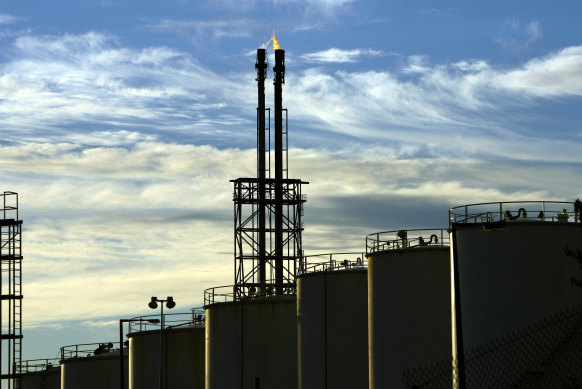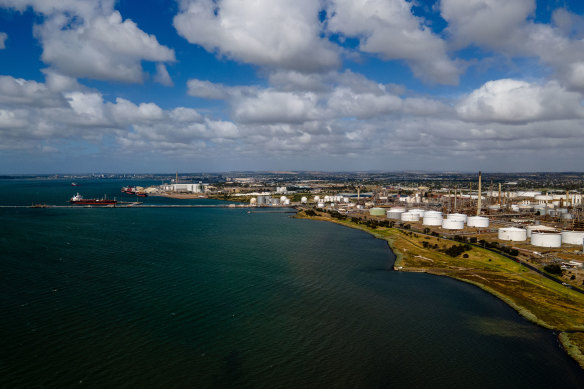By Nick Toscano and Mike Foley
A plan for Australia to start importing giant shipments of liquefied gas has been resubmitted for environmental approval amid growing concerns that gas-connected homes and businesses in the south-east could be headed for an energy crisis.
Viva Energy, one of Australia’s largest fuel suppliers, wants to extend a pier from its Geelong oil refinery to park a floating vessel able to receive cargoes of liquefied natural gas (LNG) to supply to the nation’s biggest gas-consuming state, Victoria.

Viva Energy, owner of the Geelong oil refinery, is seeking approval to begin importing liquefied natural gas into Victoria for the first time.Credit: Nic Walker
The project is billed one of the last remaining solutions to what authorities warn is an imminent shortage of domestic gas in Victoria, NSW and South Australia by as early as 2027-28, as the vast 50-year-old oil and gas fields in Bass Strait continue rapidly depleting.
Viva Energy’s environmental studies went on exhibition on Thursday and will be open for public scrutiny for 30 days before a hearing in December. If the Victorian government gave the green light, the project could start construction by 2026 and deliver gas by 2028, in time for the most severe risk of shortfalls, the company said.
“Our project is the best, and perhaps only, complete solution for Victoria because it will deliver gas close to where it is most needed,” Viva strategy chief Lachlan Pfeiffer said.
“The work we have undertaken … shows that the project will have minimal environmental impacts.”
Gas, although a key source of planet-warming carbon dioxide and methane emissions, remains widely used in heating, cooking, power generation and manufacturing processes across the nation.
Opponents of the idea of importing LNG – gas that has been super-chilled down to a liquid so it can be transported on special ships – from other parts of Australia or overseas say it is absurd to consider the proposal given Australia is one of the largest global LNG exporters behind the United States.
More should be done to hold back gas destined for the export market and reduce household gas demand rather than boost supplies, they say.
Environment Victoria climate campaign manager Joy Toose said importing LNG would further expose local energy consumers to volatile swings in international gas markets and risk driving up bills.

The Viva Energy refinery on Corio Bay.Credit: Eddie Jim
“We need to step up efforts to repower Victorian homes with renewable electricity and leave gas in the past, where it belongs,” Toose said.
However, without new ways to offset declining Bass Strait production, local supplies are running dangerously short, especially on cold winter days when gas demand is highest. That’s because massive volumes of Queensland gas production are already locked into long-term export contracts. Pipeline limitations also restrict how much gas can flow south on days of heavy winter heating demand, and gas from Western Australia cannot be transported east.
A raft of new state and federal government policies designed to slash gas demand, including banning gas hook-ups in new Victorian residences, and incentives for people to switch their gas appliances to electric alternatives, are failing to drive down gas use fast enough to avoid shortfalls, says the Australian Energy Market Operator (AEMO).
Victorian Energy Minister Lily D’Ambrosio has shifted the government’s tone on the future role of gas as the threat of shortfalls looms, stressing that the fossil fuel will have an important, albeit limited, role in the transition from coal to cleaner sources of energy. This week, she announced new laws to pave the way for offshore gas storage projects to be developed in Victoria, including in depleted gas reservoirs beneath the sea.
When Viva first proposed the Geelong LNG project in 2020, it encountered strong resistance from environmentalists and some community members, who argued it was too close to residential areas and schools, and feared it would set back Australia’s climate ambitions by entrenching the use of harmful fossil fuels.
The terminal was initially due to deliver gas by the winter of 2024, but a final investment decision was delayed amid a drawn-out environmental approvals process, and state government demands for additional information on its potential local impacts.
Campaigners who fought Viva’s LNG project during its first environmental assessment said on Thursday they were disappointed the company was pushing ahead with the controversial plan again.
“More than 2000 people and organisations made submissions against Viva’s project, including Geelong Grammar School, North Shore Residents Association, environment groups, school students, fishing enthusiasts and many other community organisations and individuals,” Australian Conservation Foundation Geelong spokesperson Sanja van Huet said.
But warnings from experts, industry players and AEMO have only intensified that time is running out to prevent the domestic market from slipping into deficit, which could drive up gas bills for those who still depend on it.
Viva Energy and billionaire Andrew and Nicola Forrest’s Squadron Energy, which is building a more-advanced LNG terminal in NSW, argue imports will be necessary as an urgent and larger-scale solution.
Rick Wilkinson, the head of Australian consultancy EnergyQuest, said the east-coast domestic gas market had “scraped through another winter”, but the outlook continued to deteriorate, with shortfalls looking increasingly likely unless new supply came online.
Despite authorities including AEMO and the Australian Competition and Consumer Commission predicting annual shortfalls by 2027 or 2028, disruptions could emerge much sooner on days of extreme winter gas demand, he said.
“Peak demand shortfalls are what will turn the lights off and shut industry down, and they are likely to arrive sooner than annual shortfalls,” he said.
The Business Briefing newsletter delivers major stories, exclusive coverage and expert opinion. Sign up to get it every weekday morning.